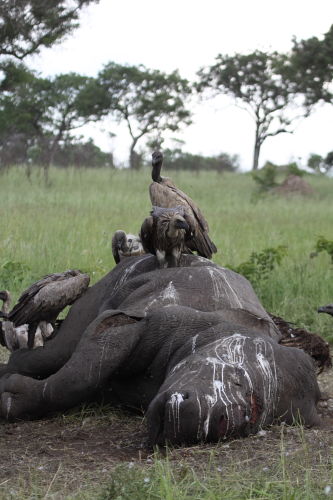Early on the morning of New Years Eve a rhino was found close to Little Bush Camp and it had been killed. Fortunately with all the rhino controversy throughout South Africa
It is mid summer and a lot of female elephants fall into oestrus this time of the year as that means that there calves will be born in the summer almost 2 years from now. Together with the females in oestrus come the males who who are looking to spread their seed. These bulls are often in a state called musth, which is when their bodies are producing mass amounts of testosterone and other hormones and this gives them the extra strength to travel long distances between herds to find females who are in oestrus. But much like steroids these extra hormones also make these bulls highly aggressive and unpredictable. On drives we generally keep clear of these guys to avoid any unwanted attention.
When the rhino was found it seemed like it had not been dead too long, maybe a few hours. On my way back from drive the night before we had passed a large breeding herd of elephants not far from the murder site, and we could smell a bull in musth. They give off a strong, sweet odour from their urine as their body tries to deal with the elevated hormone levels.
At some time during that night or the early hours of the next morning this large bull elephant had a confrontation with this rhino bull and pierced his side with his tusks, killing the rhino. The rhino was found in the Msutlu river and was moved to an open area to allow for better viewing as there would be lots of action around the carcass for the next few days.
His horns were removed so as not attract any attention from poachers and will be taken to the South African National Parks Board for micro chipping to ensure that the horn cannot be traded.
For the next few days the activity around the carcass was frantic. Hundreds of vultures came in to feast on the two ton animal. I managed to count 5 different species around the carcass including rare cape and white headed vultures. It took a few days before we saw any big predators but eventually we saw leopard on three occasions around or feeding on the carcass and inevitably the hyenas came. At one stage there were eight around the carcass crunching away at the bone, eating the skin and climbing right inside the carcass to get to whatever meat they could.
It took 7 days and the entire carcass had been picked clean, the only remaining bones are the vertebrae and lower jaw, although there is still a very strong odour of death hanging around. The top of the skull I suspect has been dragged off by the hyenas. All in all a crazy seven days with daily visits for all the safaris to see what was happening.
Day 1 - The vultures were the first to find the carcass and moved in in their hundreds!
Day 2
Day 3
Day 4
Day 5
Day 6
Day 7













VERY interesting Richi. Your photos are sooo good :)
ReplyDelete